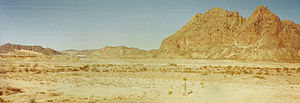This is an old revision of this page, as edited by SightWatcher (talk | contribs) at 01:18, 25 February 2012 (→Events: Tweaked sentence a bit). The present address (URL) is a permanent link to this revision, which may differ significantly from the current revision.
Revision as of 01:18, 25 February 2012 by SightWatcher (talk | contribs) (→Events: Tweaked sentence a bit)(diff) ← Previous revision | Latest revision (diff) | Newer revision → (diff)


Terlingua (Ghost Town) is a mining district in southwestern Brewster County, Texas, United States. It is located near the Rio Grande and the Texas villages of Lajitas and Study Butte, Texas,as well as the Mexican village of Santa Elena. The discovery of cinnabar, from which the metal mercury is extracted, in the mid-1880s brought miners to the area, creating a city of 2,000 people. The only remnants of the mining days are a ghost town of the Howard Perry-owned Chisos Mining Company and several nearby capped and abandoned mines, most notably the California Hill, the Rainbow, the 248 and the Study Butte mines. The mineral terlinguaite was first found in the vicinity of California Hill.
History
According to the historian Kenneth Baxter Ragsdale, "Facts concerning the discovery of cinnabar in the Terlingua area are so shrouded in legend and fabrication that it is impossible to cite the date and location of the first quicksilver recovery." The cinnabar was apparently known to Native Americans, who prized its brilliant red color for body pigment. Various Mexican and American prospectors reportedly found cinnabar at Terlingua in the 1880s, but the remoteness and hostile Indians deterred mining.
A man named Jack Dawson reportedly produced the first mercury from Terlingua in 1888, but the district got off to a slow start. It was not until the mid-1890s that the Terlingua finds began to be publicized in newspapers and mining industry magazines. By 1900, there were four mining companies operating at Terlingua.
The name “Terlingua” refers to a mining district in Texas’ southwestern Brewster County. It is located near the Rio Grande and the Texas villages of Lajitas and Study Butte as well as the Mexican village of Santa Elena. The discovery of cinnabar – from which the metal mercury is extracted – in the mid-1880s, drew miners to the area, creating a city of 2,000 people. Now, the only remnants of the mining days are a ghost town of the Howard Perry-owned Chisos Mining Company and several nearby capped and abandoned mines, most notably the California Hill, the Rainbow, the 248 and the Study Butte mines. (The mineral terlinquaite was first found in the vicinity of California Hill.)
Events
Due to its proximity to Big Bend National Park, today Terlingua is mostly a tourist destination for park visitors. Rafting on the Rio Grande, mountain biking, camping, hiking, and motorcycling are some of the outdoor activities favored by tourists.
On the first Saturday of November, over 10,000 "chiliheads" convene in Terlingua for two annual chili cookoffs: the Chili Appreciation Society International and the Frank X. Tolbert / Wick Fowler World Chili Championships. In the late 1970s the Chili Cook-Off sponsored a “Mexican Fence-Climbing Contest” to spoof the U.S. Government’s planned reinforcement of the chain-link fence separating El Paso, Tex. from Cd. Juárez, Mexico and San Ysidro, Cailf. From Tijuana, Mexico. The fence the “chili heads” used was constructed by undocumented Mexican workers who labored annually for the Cook-Off organizers at five dollars a day plus meals and rustic lodging. Among the founders of the first chili cookoff in 1967 was car manufacturer Carroll Shelby, who owned a 220,000-acre (890 km) ranch nearby.
Education
Terlingua is served by the Terlingua Common School, which serves Terlingua Elementary and Big Bend High.
References
- Dumble, E.T. (1900). "Cretaceous and Later Rocks of Presidio and Brewster Counties", Transactions of the Texas Academy of Sciences for 1899, Together With The Proceedings From The Same Year. The Texas Academy of Sciences. Retrieved May 20, 2009. Describes c. 1894 and 1897 examinations in the area.
- Kenneth Baxter Ragsdale (1976) Quicksilver: Terlingua and the Chisos Mining Company, College Station: Texas A&M University Press, p.14-17.
- American Mining Congress (1905). "Quicksilver Deposits of Terlingua District, Brewster County, Texas" Proceedings of the Eighth Annual Session of the American Mining Congress, El Paso, Texas, November 14, 15, 16, 17 and 18, 1905. pp. 184–194. Retrieved May 20, 2009.
- Hill, Benjamin Felix (1902). The University of Texas Mineral Survey, Bulletin No. 4, October, 1902: The Terlingua Quicksilver Deposits, Brewster County. Austin: The University of Texas. Retrieved May 20, 2009. Includes numerous c. 1902 photos of area mining operations.
- Photo (c. 1905) of the Terlingua Mining Company's furnace in Simonds, Frederic William (1905). The Geography of Texas. Boston: Ginn & Company. p. 104. Retrieved May 20, 2009.
- http://www.desertusa.com/mag07/nov07/terlingua.html
- Miller, Tom. On the Border: Portraits of America’s Southwestern Frontier, p. 102.
- Egan, Peter (September 2008). "Viva Terlingua!". Road & Track. 60 (1): 107–109.
{{cite journal}}: Cite has empty unknown parameter:|coauthors=(help)
External links
- Terlingua, Texas from the Handbook of Texas Online
- U.S. Geological Survey Geographic Names Information System: Terlingua, Texas
- Terlingua Homecoming Documentary
- West Texas Weekly, a local weekly newspaper.
| Municipalities and communities of Brewster County, Texas, United States | ||
|---|---|---|
| County seat: Alpine | ||
| City |  | |
| CDPs | ||
| Other communities | ||
| Ghost towns | ||
| Annexed former counties | ||
29°19′18″N 103°36′58″W / 29.32167°N 103.61611°W / 29.32167; -103.61611
Categories: